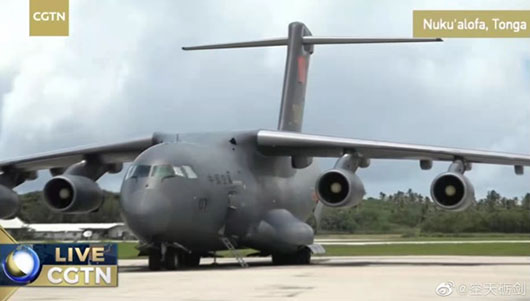by WorldTribune Staff, February 10, 2022
On Jan. 15, a massive underwater volcanic explosion devastated the South Pacific island nation of Tonga. China is using a humanitarian supply mission to the island as a preview of the invasion capabilities of the People’s Liberation Army (PLA), an analyst said.
Australia and New Zealand were the first to come to Tonga’s aid, sending a Royal Australian Air Force C-17 heavy transport aircraft and a Royal New Zealand Air Force C-130 medium transport aircraft loaded with emergency supplies on Jan. 20.

On Jan. 27, the PLA Air Force (PLAAF) “dispatched two of its Xian Aircraft Corporation Y-20 heavy transports, delivering 33 tons of supplies to Tonga,” Rick Fisher, a senior fellow at the International Assessment and Strategy Center, wrote in a Feb. 8 analysis for The Epoch Times.
The Y-20 is currently the largest indigenous PLA strategic transport aircraft, that will soon have a capacity for over 60 tons.
On Jan. 31, the People’s Liberation Army Navy (PLAN) dispatched a 25,000-ton Type 071 landing platform dock (LPD) amphibious assault ship, accompanied by a 52,000 ton Type 901A underway supply ship, to take 1,400 tons of aid and supplies to Tonga.
The Type 071 could carry 800 to 1,000 troops and dozens of armored vehicles and up to four large helicopters.
“China’s use of two of its largest platforms for military power projection to deliver humanitarian relief, is also a reminder that in the future they could be delivering troops and armored vehicles,” Fisher wrote in a Feb. 1 analysis for Geostrategy-Direct.com.
“It is also a clear demonstration to Australia, New Zealand and the United States that the PLA can reach the South Pacific very quickly to shore up allied governments under siege or to attack the interests of the democracies.”
Related: China uses Tonga disaster to demonstrate South Pacific power projection, February 1, 2022
Fisher noted that after years of the communist regime in Beijing’s “outright economic and political bullying of U.S. ally Australia, expanding its penetration of some of the weaker island states like Tonga, Fiji, and Vanuatu, and using its economic power to build influence in New Zealand, there was a reaction. On Sept. 15, 2021, Australia, the United Kingdom, and the United States signed the AUKUS defense arrangement to equip Australia with nuclear-powered attack submarines.”
Fisher continued: “On one level, AUKUS was a political master stroke, at once highlighting and threatening Chinese Communist Party (CCP) ambitions for Asian hegemony. On another level, it can be seen as a rather lagging deterrent because the Royal Australian Navy may not get its nuclear submarines for a decade or more. The problem is that the PLA is already a major threat in the South Pacific, with the current capability to conduct punitive invasions, blockades, or to even invade and conquer New Zealand. These capabilities will increase rapidly over the coming decade.”
If supreme leader Xi Jinping were to decide to invade New Zealand, China’s 11 LPDs and LHDs could transport 10,000 troops and hundreds of light- and medium-weight armored vehicles, or enough for two medium-weight PLA Ground Force or PLA Marine brigades,” Fisher wrote. “With its two, soon to be three, aircraft carriers, the PLAN could send about 75 combat aircraft to attack all targets of consequence in New Zealand. The PLA could then deploy a brigade each on New Zealand’s North Island and South Island.”
Meanwhile, Fisher added, “thanks to decades of ‘woke’ governments, New Zealand lacks the military forces to offer much resistance. The Royal New Zealand Army could mobilize about 4,600 troops, but only has 25 lightly-armed infantry fighting vehicles.”
INFORMATION WORLD WAR: . . . . How We Win . . . . Executive Intelligence Brief
